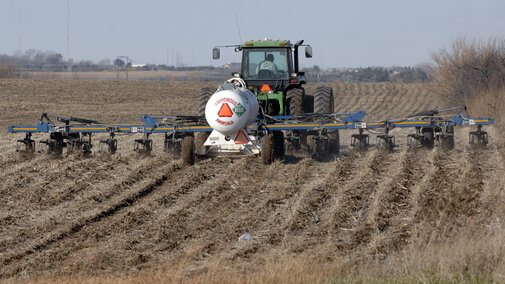Low fertilizer-N costs, time availability, and generally drier soils compared with spring conditions often contribute to a preference for fall fertilizer-N application. However, when compared with spring or in-season application, fall application often results in relatively high levels of soil nitrate-N when the potential for leaching and denitrification is high.
Nitrate-N is highly vulnerable to loss by leaching and denitrification. The risk is greatest from late April to June (Figure 1), implying a need to minimize soil nitrate-N at that time. This is especially true for sandy loam or sandier soils where the risk of nitrate leaching is high for much of the year (Nutrient Management for Agronomic Crops in Nebraska; pages 3-16).
Fertilizer-N application typically increases soil ammonium which is microbially nitrified to nitrate when the soil has adequate water and high enough temperature. Soil microbial activity and the rate of conversion of ammonium to nitrate is very low when the soil temperature is less than 50oF. With increased temperatures, there is a rapid increase in the rate of nitrification.

Fall Application in 2019
The soil water content at this time is a major consideration in fall application decisions. Soil water is higher than normal for much of Nebraska’s cropland, indicating higher than normal leaching and denitrification potential for next spring. Soils are much more compacted by traffic when soils have a high water content as compared to when the available soil water is less than 60% of field capacity. However, given current soil water levels, it is likely that soil water levels will be even higher in the spring of 2020 with even more potential for compaction.
If you are planning a fall N fertilizer application, consider the following.
- Apply fertilizer-N (and manure) when the soil temperature is below 50°F at the 4-inch soil depth and trending cooler (Check CropWatch Soil Temperature).
- Apply anhydrous ammonia rather than other N fertilizers.
- Limit fall application of N to silt loam, silty clay loam, and finer textured soils.
- Use nitrification inhibitors to slow the conversion of ammonium to nitrate, especially on sand-dominant soils.
- Avoid fall application on wet soils.
- Consider applying a lower base rate of nitrogen in the fall and plan on applying the rest at planting, or as a side-dress application.
- Follow the UNL recommendations and plan to apply 5% more fertilizer-N compared with spring application to compensate for likely N losses.

